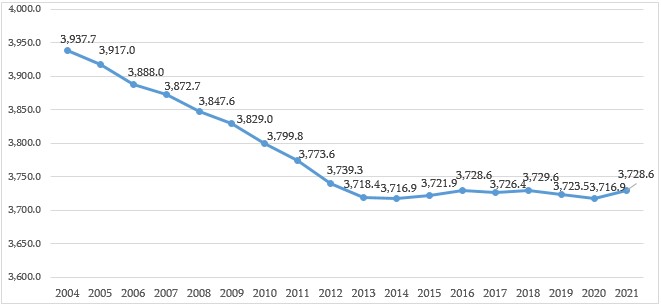Irakli Gharibashvili: “Under the Georgian Dream’s rule, the number of the population increased by 10,000.”
Verdict: MANIPULATION
Mikheil Saakashvili: “During my presidency, we had a positive net migration rate. There were more people coming to the country than leaving. Under their rule, according to the last year’s data, 700,000 persons left the country.”
Verdict: MANIPULATION
Resume: As compared to 2020, the population of Georgia increased by 11,700 which was stipulated by declining migration flows in 2020 which in turn was related to the COVID-19 pandemic and the closing of borders. If we exclude the effect of the pandemic, the number of the population decreased by 1,500 under the Georgian Dream’s rule from 1 January 2013 to 1 January 2020. Therefore, Irakli Gharibashvili’s statement is a MANIPULATION.
Both under the incumbent and the previous governments, emigration is indeed one of Georgia’s major challenges which causes a decrease of the population. The National Statistics Office of Georgia recalculated migration figures vis-à-vis the number of the population and emigration based on the data of the 2014 universal public census. According to the National Statistics Office of Georgia, the net migration rate (the difference between emigrants and immigrants) is negative from 1994 to 2020 which means that annually more people leave Georgia than come to Georgia. According to the older data, the net migration rate in the period between the censuses was positive. However, it did not provide a real picture because it was impossible to have accurate figures of migration flows given the lack of a relevant system in the years before 2012. Therefore, Mikheil Saakashvili’s statement that the net migration rate was positive under his presidency is a MANIPULATION.
It is inappropriate to sum up the yearly figures of emigrants, since it is possible that a person who is no longer in emigration is still counted as an emigrant. On other hand, data duplication is also possible. For instance, one and the same individual may emigrate two or more times in the past years. The reasons why summing up the number of immigrants is also inappropriate are the same. Therefore, it would be relevant if we analyse the difference between emigrants and immigrants. In 2013-2020, the net migration balance is -26,200 meaning 26,200 more people left the country as compared to those who entered. Therefore, Mikheil Saakashvili’s statement that 700,000 people left Georgia under the Georgian Dream’s rule is not true.
Of additional note is that Georgia had a net positive migration balance for the first time in 2020. This, in turn, was stipulated by the COVID-19 pandemic and the closing of the borders. According to the data of the National Statistics Office of Georgia, the net migration rate; that is, the difference between the numbers of emigrants and immigrants, was 15,732 in 2020.
Analysis
The Prime Minister of Georgia, Irakli Gharibashvili, stated: “Opponents always criticise and say that the population decreased under our rule. It is not something to boast about but this figure increased by 10,000.” The Prime Minister also added: “Under the previous government, during Saakashvili’s time, Georgia’s population decreased by 219,000 people.”
The third President of Georgia, Mikheil Saakashvili, responded to the Prime Minister’s statement and said it was an unparalleled lie: “He said that during Saakashvili’s time more than 200,000 people left and over 100,000 entered during their time. This is an absolute lie! Two years ago, there was a number in the National Statistics Office of Georgia, before it was amended, that during my presidency we had a net positive migration balance. This does not mean that people were not leaving the country, but more were coming as compared to those who were leaving. During their times, according to the last year’s data, 700,000 people left and at least 100,000 already joined them this year.”
As of 1 January 2021, Georgia’s population is 3,728,600 which is 10,200 more as compared to its population on 1 January 2013. In 2021, Georgia’s population increased by 11,700 as compared to 2020 which was stipulated by decreased migration flows in 2020. In turn, this was caused by the COVID-19 pandemic and the closing of the borders. If we exclude the effect of the pandemic, the number of the population decreased by 1,500 under the Georgian Dream’s rule from 1 January 2013 to 1 January 2020. Therefore, Irakli Gharibashvili’s statement is a MANIPULATION.
Under the previous government’s rule (1 January 2013 as compared to 1 January 2004), Georgia’s population decreased by nearly 219,000. Of additional note is that given the 2014 universal public census results, the previous years’ figures have been recalculated. According to the old data, the population was increasing. The figure from the period prior to 2014 reflects an artificial indicator in order to technically adjust the population figure for the period between the censuses and not an objective reality. However, there is no dispute that Georgia’s population has been declining since 1994 which is associated with the growth of external migration flows.
Graph 1: Number of Population as of 1 January 2021 (Thousand)

Source: National Statistics Office of Georgia
The number of the population as well as migration figures have always been the subject of manipulation both from the government and the opposition. At first, it should be clarified that the National Statistics Office of Georgia recalculated the basic demographic indicators in 2018 which were based on the 2014 universal public census results. As a result, Georgia’s population decreased from 4.5 million (2002 figure) to 3.7 million. Inaccuracies in the 2014 universal public census and external migration flows were named as the reasons behind the sharp drop in the number of the population. The 2002 universal public census results have been revised and the number of the population for 2002 was cut by 8.7% (to 3.9 million) based on alternative data (including a domestic households integrated survey). The difference between the corrected figures for the 2002 and the 2014 universal public census results were mostly distributed on migration.
Emigration is indeed one of Georgia’s top challenges which in turn causes a population decline. According to the data of the National Statistics Office of Georgia, the net migration rate (the difference between emigrants and immigrants) [1] was negative from 1994 to 2020, meaning that more people leave the country than enter it. The National Statistics Office of Georgia has drastically altered the net migration rate figures. According to the updated figures, the net migration rate has been negative every year since 2002. According to the old data, however, the net migration rate in the period between the censuses was positive. However, it turned out that the older figures did not provide a real picture. An accurate calculation of the migration flows was impossible prior to 2014 because of the lack of a relevant system. Since 2004, the net migration rate has been mostly calculated by the so-called expert assessments. Since 2004, the National Statistics Office of Georgia has border crossing data; however, the identification of immigrants and emigrants was not able to be done and these figures in fact included every individual who left or entered the country’s territory. Since 2012, a new methodology has been introduced which made it possible to identify immigrants and emigrants. The National Statistics Office of Georgia recalculated the migration figures based on the 2014 census data for the number of the population and emigration. Therefore, Mikheil Saakashvili’s statement that the net migration rate was positive during his rule is a manipulation.
It is inappropriate to sum up the yearly figures of emigrants, since it is possible that a person who is no longer in emigration is still counted as an emigrant. On other hand, data duplication is also possible. For instance, one and the same individual may emigrate two or more times in the past years. The reasons why summing up the number of immigrants is also inappropriate are the same. If we sum up, a total of 741,787 people left the country in 2013-2020 (the data for 2021 are not yet available). In the same period, however, 731,787 people came back to Georgia.
The net migration rate was -26,200 in 2013-2020 which means that 26,200 more people left the country as compared to those who entered it. Therefore, Mikheil Saakashvili’s statement that 700,000 people left Georgia under the Georgian Dream’s rule is not true.
The year 2020 was the first time when Georgia had a net positive migration rate which in turn was stipulated by the COVID-19 pandemic and the closing of the borders. According to the data of the National Statistics Office of Georgia, the net migration rate; that is, the difference between the numbers of emigrants and immigrants, was 15,732 in 2020. In 2020, 74,264 people (43,394 Georgian nationals and 30,914 foreign nationals) permanently residing in Georgia emigrated from the country which is 29.3% less as compared to the figure for 2019. The decrease in the number of emigrants was caused by a nearly halved migration of Georgian nationals abroad. In addition, 66,668 Georgian citizens returned to the country from abroad in 2020 which is 22% more as compared to the previous year’s figure. However, the number of immigrants also decreased by 7.1% in 2020 and amounted to 89,996 people. This decline was stipulated by the decrease in foreign nationals emigrating to Georgia from abroad. Despite the reduced figures of immigration, emigration dropped even further, resulting in the net positive migration rate.
[1] Both emigrants and immigrants could be either Georgian citizens or citizens of foreign countries. According to the methodology of the National Statistics Office of Georgia, a person is considered as an emigrant if he left Georgia in the last 12 months, stayed in another country for at least 183 days and his permanent place of residence prior to leaving the country was Georgia; that is, he spent at least 183 days in Georgia in the previous 12 months. A person is considered as an immigrant if he spent at least 183 days in Georgia after crossing the border and Georgia was not the place of his permanent residence prior to crossing the border.








